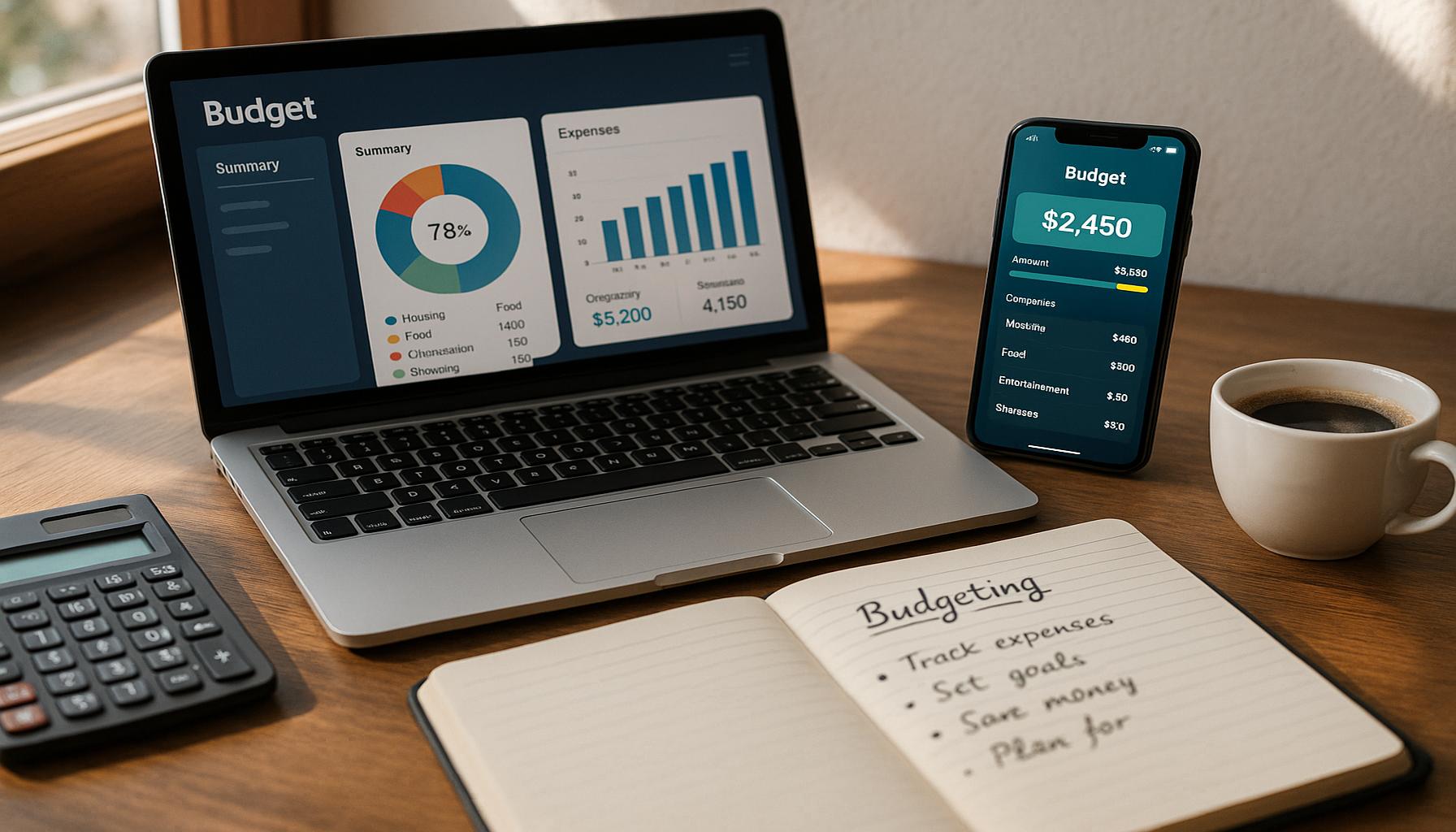Comparison of Budgeting Apps: Which is Best for You?

Managing personal finances effectively is a skill that can lead to reduced stress and improved overall financial health. One of the most practical tools available to help with this is budgeting apps. These modern solutions allow individuals to take control of their financial journeys with ease and precision.
Why Use a Budgeting App?
Budgeting apps provide a variety of benefits that simplify the process of managing money:
- Tracking Expenses: One of the most compelling reasons to use a budgeting app is for tracking expenses. By automatically categorizing your spending, these apps can provide insights into where your money is going, helping identify patterns that may surprise you. For instance, you might discover that dining out takes up a significant portion of your monthly budget, prompting you to consider cooking at home more often.
- Setting Goals: Budgeting apps can assist in setting goals for savings, such as an emergency fund, vacation, or debt repayment. Many apps allow users to create customizable savings goals and track their progress visually, making it easier to stay motivated. For example, if you want to save $1,200 for a vacation, a budgeting app will show you how much to save each month to reach that goal.
- Accessibility: With mobile capabilities, you can access your budget anywhere and anytime. This flexibility is particularly useful for those who are always on the go, allowing you to keep your financial information at your fingertips. Whether you’re shopping for groceries or planning a trip, you can quickly check your budget to make informed decisions.
Types of Budgeting Apps
Understanding the different types of budgeting apps available can help you choose the one that best fits your lifestyle and financial objectives. Here are some common types:
- Expense Trackers: These apps primarily focus on logging and categorizing expenses. Examples include PocketGuard and GoodBudget, both of which simplify tracking your daily spending without overwhelming you with additional features.
- Full-Featured Financial Apps: These platforms, like Mint or YNAB (You Need a Budget), provide comprehensive tools for budgeting, expense tracking, and investment management. They often connect directly to your bank accounts, offering a holistic view of your finances.
- Zero-Based Budgeting Apps: Apps like EveryDollar encourage users to adopt a zero-based budgeting approach, where every dollar earned is allocated to specific expenses. This method promotes intentional spending and aligns perfectly with financial goals.
This guide will further explore popular budgeting apps by comparing their features, usability, and costs. By the end, you’ll have a clear understanding of which app will best support your financial journey, enabling you to take charge of your finances confidently. No matter your financial situation or goals, there’s likely an app tailored to meet your needs.
Evaluating Popular Budgeting Apps
With numerous budgeting apps available, selecting the right one can feel overwhelming. To make the decision process simpler, we will examine a few popular choices based on their features, strengths, and user experiences. Each app serves different financial needs and preferences, providing options for budgeters at every level of expertise.
1. Mint
Mint is widely recognized and trusted in the budgeting app space, known for its comprehensive financial management features. Upon signing up, users can link their bank accounts, credit cards, and bills, allowing Mint to aggregate financial information into one easily accessible platform. The app provides a intuitive and visually appealing dashboard, which makes tracking your spending patterns simple. Key features include:
- Expense Tracking: Mint automatically categorizes transactions, giving users quick insights into spending habits.
- Budget Creation: Users can create budgets based on historical expenses, ensuring it aligns with their financial goals.
- Credit Score Monitoring: Mint offers free credit score tracking, helping users view their credit health holistically.
Mint’s main drawback might be its reliance on advertisements and promotional offers, which can sometimes take focus away from budgeting. However, its free service makes it an attractive option for budgeters looking to have everything in one place without paying a fee.
2. YNAB (You Need a Budget)
YNAB stands out for its unique budgeting philosophy that encourages users to assign every dollar a specific job. It employs the zero-based budgeting approach, aiming to help users prioritize their expenses and savings effectively. This app is especially beneficial for those struggling with overspending. Features of YNAB include:
- Goal Tracking: Users can set up savings goals and YNAB helps track progress toward those targets.
- Real-Time Sync: App users can access their budgets across devices, which ensures they remain updated on their financial status.
- Educational Resources: YNAB offers extensive educational content, empowering users to improve their budgeting skills and financial literacy.
While YNAB carries a monthly or annual subscription fee, many users find that the investment leads to significant savings over time due to its structured approach to budgeting.
3. PocketGuard
PocketGuard aims to simplify budgeting by providing a clear picture of how much disposable income is available after accounting for bills, goals, and necessities. Its user-friendly interface and straightforward tracking system makes it particularly appealing to those new to budgeting. Key features of PocketGuard include:
- In-Pocket Balance: This feature allows users to see exactly how much money they have left to spend after covering essential costs.
- Automated Tracking: PocketGuard automatically categorizes transactions and tracks your spending in real time.
- Bill Reminders: The app offers reminders for upcoming bills, preventing late payments and potential fees.
Though it lacks some depth in terms of comprehensive financial planning, PocketGuard can be an ideal choice for minimalists or anyone seeking to gain simpler control over their spending.
As you explore these popular budgeting apps, consider your individual needs and financial practices. Each app features unique aspects tailored to different budgeting styles, so reflect on what will best support you on your financial journey.
Exploring More Budgeting Apps
In addition to Mint, YNAB, and PocketGuard, there are several other budgeting apps that cater to different user preferences and financial goals. Let’s delve into a few more noteworthy apps, highlighting their strengths, target users, and unique features that set them apart in the crowded sea of budgeting tools.
4. EveryDollar
EveryDollar is a straightforward budgeting app created by financial expert Dave Ramsey. It applies the zero-based budgeting approach, similar to YNAB, but emphasizes simplicity and ease of use. Users can manually enter expenses and income, helping them see where every dollar is going. Key features of EveryDollar include:
- User-Friendly Interface: The app is designed for simplicity, making it ideal for those new to budgeting or who prefer a straightforward approach.
- Add Your Expenses: Unlike some automated apps, EveryDollar focuses on manual entry, which can enhance users’ awareness of their spending habits.
- Financial Peace University Integration: For those following the Dave Ramsey plan, EveryDollar integrates seamlessly with Financial Peace University, offering additional resources.
While the free version of EveryDollar lacks bank syncing features, users can opt for the premium version that allows automatic updates, saving time on data entry.
5. GoodBudget
GoodBudget is based on the traditional envelope budgeting method, which divides income into different spending categories. This virtual envelope system is particularly effective for users who appreciate a tactile approach to managing their finances. Features include:
- Envelope Budgeting: Users can create virtual envelopes for different categories, ensuring they stick to their planned spending.
- Sync Across Devices: This allows users to share their budget with family members or partners, facilitating collaborative budgeting.
- Debt Tracking: GoodBudget also helps users manage their debt payments alongside their budget, fostering a comprehensive view of their finances.
GoodBudget is excellent for those who prefer to see their finances segmented into specific categories, but it may require more manual effort compared to other apps that automate tracking.
6. Personal Capital
If you are looking for a budgeting app with a strong focus on investments and net worth rather than just spending, Personal Capital may be the right choice for you. With its dual functionality as a budgeting and investment tracking tool, Personal Capital offers several advantages:
- Net Worth Tracking: Users can link their accounts to visualize their total assets and liabilities, getting a clear picture of their financial health.
- Investment Analysis: The app provides insights into investment performance, fees, and asset allocation, which is beneficial for those planning for retirement.
- Financial Planning Tools: Users enjoy access to retirement planning calculators and educational resources that help optimize their investment strategy.
While Personal Capital is ideal for users with investment portfolios, it may not cater as effectively to those solely focused on monthly budgeting and expense tracking.
When evaluating these options, consider the features that align with your financial habits and goals. Each app brings its unique strengths to the table, which allows you to select the most suitable one for your personal situation.
Conclusion
In conclusion, choosing the right budgeting app is essential to effectively manage your finances and achieve your financial goals. With the variety of options available, including Mint, YNAB, and PocketGuard, as well as others like EveryDollar, GoodBudget, and Personal Capital, there is truly something for everyone, depending on your preferences and needs.
If you are looking for a comprehensive solution, Mint might be your best bet, as it offers a wealth of features for both budgeting and tracking expenses. For those who favor a more hands-on approach, YNAB provides valuable resources to promote proactive financial behaviors. On the other hand, if simplicity is your priority, EveryDollar could be the right fit.
For users who value visual spending categories, GoodBudget‘s envelope system can help foster discipline in spending, while Personal Capital stands out for those with investment interests, merging budgeting with investment tracking seamlessly.
When deciding which app aligns best with your financial habits, consider factors such as ease of use, the degree of automation desired, specific financial goals, and whether you prefer a collaborative budget or a more individual-focused approach. By evaluating these aspects, you can select a budgeting tool that not only simplifies your financial management but also empowers you to take control of your financial future.
Related posts:
Techniques to Improve Business Revenue and Expense Management
Resources for Entrepreneurial Women to Improve Their Finances in the USA
How to Pay Less Taxes in the USA as a Business Owner
How to Create a Financial Plan for Your Business Expansion
Strategies to Improve the Relationship Between Income and Expenses
Techniques to Adjust the Company's Budget in Times of Uncertainty

James Carter is a financial writer and advisor with expertise in economics, personal finance, and investment strategies. With years of experience helping individuals and businesses make complex financial decisions, James offers practical insight and analysis. His goal is to give readers the knowledge they need to achieve financial success.